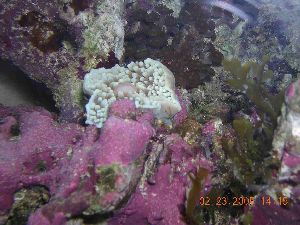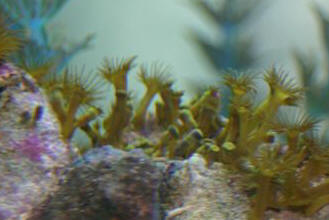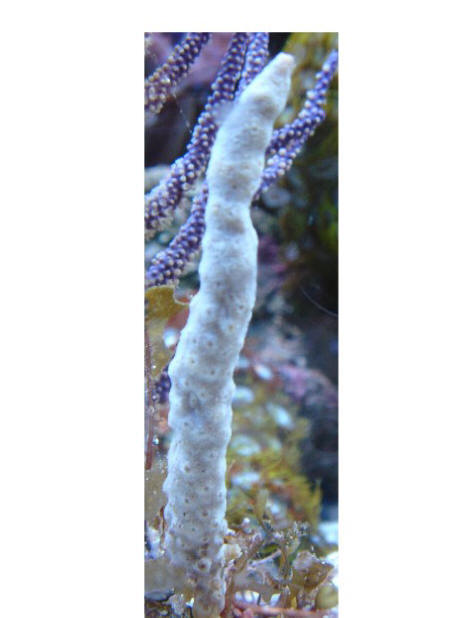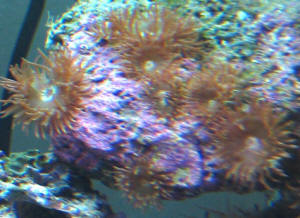|
FAQs on Identification of Stinging-Celled
Animals 2
Related Articles: Cnidarians, Water Flow, How Much
is Enough,
Related FAQs: Cnidarian IDs 1, Cnidarian IDs 3,
Cnidarian IDs 4, Cnidarians ID 5,
Cnidarians ID 6, Cnidarian ID 7, Cnidarian ID 8, Cnidarian ID 9, Cnidarian ID 10, Cnidarian ID 11, Cnidarian ID 12, Cnidarian ID 13, Cnidarian ID
14, Cnidarian ID
15, Cnidarian ID
16, Cnidarian ID 17, Cnidarian ID 18, Cnidarian ID 19, Cnidarian ID 20, Cnidarian ID 21, Cnidarian ID 22, Cnidarian ID 23, Cnidarian ID 24, Cnidarian ID 26, Cnidarian ID 27, Cnidarian ID 28,
Cnidarian
ID 29,
Cnidarian ID 30,
Cnidarian ID 31,
&
Anemone ID 1, Aiptasia
ID 1, Stony Coral ID
1,
Mushroom Identification, Soft Coral ID, Alcyoniid ID, Xeniid ID,
|

|
Yellow polyp not opening Hey
guys, <Cheers> It's 8:30 am in Montreal and the weather is
cold. Sometimes I wonder why we all live here!! <I have
traveled places like that myself... Arizona in August... Boston in
January... why, why, why are human beings habitating there. Moreover...
how?!?!> Well... my question in straightforward, my yellow polyp
which I bought two weeks ago is not opening up. I searched your site
and could not pinpoint the problem. <The first problem here is
that we cannot know what coral specifically you are talking about
(common names mean little). By yellow polyps do you mean Parazoanthus,
Tubastrea, A Sarcophyton, etc.?> He was opened at the LFS under
power compact light. All my parameters are within normal range, except
calcium which is 260. <Do water changes to get your Calcium and
Alkalinity more even keeled (probably high from mis-dosing
supplements). Read here too, brah: http://www.wetwebmedia.com/calcalkmar.htm
> I do have 175 MH lights. The polyp is placed midrange, with
moderate to heavy flow and moderate lighting. <I'm
thinking/fearing, hearing a lack of QT for this new coral here. Sigh.
It may explain light shock if any... or illness from infection or
disease pending and possibly at risk of infecting your display, etc.
You may learn a very hard lesson mate. I do hope not. Yet you need(!)
to understand and apply strict quarantine habits for all new livestock
if you will be a conscientious aquarist> I've been feeding him
Marine Snow every second day and I just started feeding him Mysis
shrimp. I went to my LFS and he said that usually these pacific type
polyps like lower levels of light, so now he's at the bottom of the
tank. Oh yeah, one other thing, he's not attached to any type of
sponge but rather just live rock. Any thoughts, should I let it be or
should I be worried? Nilesh <Do send a scientific name and/or pic
for us to be clear here. Kindly, Anthony>
| Yellow polyps Hi. my name is Luke and I have a question
on the polyps I recently purchased. They have turned a brownish
color and I and they sometimes swell up with water. I
saw one today that had its mouth completely open to where
you could see inside it. I have been feeding them 1-2
times a week with fine grated raw frozen shrimp or
enriched brine I have about 205 watts of lighting over
them but no white bumps that would indicate light burn. There
were a few that were kinda black and didn't open but is the
swelling up with water a good or bad thing.
Some are yellowish brown some are a lot darker brown and
do not open all the way any help would be great thanks
in advance. Luke <Luke... these look like Aiptasia to
me... pest anemones. Please see WWM re. Bob Fenner> |
|

|
| Re: Yellow polyps ID Negative Bob they are not Aiptasia
I know what those are. They were yellow when I bought
them I don't know why they would turn brown and my
LFS owner has been in the marine trade for about 30
years and his tanks have no Aiptasia in them. Hmmm so Im
not to sure whats going on with them but I
don't really have the worlds best lighting so maybe
that's it? <Appears to be... Mmm, my next guess
is some sort of zoanthid... Would you be able to send a better pic,
close-up of one of these polyps? Bob Fenner> |
Gorgonian Identification
Hi, <Hi Kevin, MacL here with you today.> You seem to know a
lot about gorgonians, so I was wondering what type this is, it came
on a purple gorgonian that I bought. <Without the polyps being
extended its very hard to tell Kevin. Can you get an additional
picture with them out?> How much do you thing this little frag
would go for? <That's a tough question because price
fluctuates depending on the area.> thank you,
Kevin |
 |
Mystery Coral ID - Can't
Quite, Despite Detailed Description 4/12/05 I do hope that my
grammar and sentence structure and whatnot was clear enough to make
sense. I apologize if it is difficult to read; I'm ADHD as all
Hades, and the complexity of trying to describe my mystery coral was
boggling to even my language-oriented mind. <Ha! Boy did you
get the right guy! No worries, despite my own ADHD, I will work
through.<g>> Hi. First of all I'd like to thank you for
your site and all you do to help out the hobby. <It truly is a labor
of love.> I'm new to reef-keeping, though it is by far the most
satisfying thing I have ever done. I seem to have an affinity for
reef-aquariums; they do very well for me, and my intuition has
generally solved more of the challenges that have arisen than
research--but research is a love of mine regardless, and when I have
needed information to fuel my intuitive leaps, this website has proven
to be largely the only reliable source. So again, thank you. <Thanks
for the kind words. We work hard to provide reliable basic info, not
chase the latest trends. Glad you have benefited!> Now, on to my
question...I have a habit of "buying" (mostly being flat-out
given for free along with some other purchase I'm making) little
tiny frags and single polyps etc. that I notice neglected on the bottom
of my LFS's aquariums after new shipments and whatnot. These things
are generally "probably just going to die anyhow," and are
not really paid much attention to. I love this, though; my favourite
thing about this hobby is how things grow, and out of every
unappreciated, overlooked probably-just-going-to-die-anyhow piece or
polyp I've gotten since I started this, I've only had two
deaths. <Kudos on having the conscience and patience to take
this approach! It sure is great to watch these things grow and to see a
whole colony that you grew from a single polyp!> Up until the other
day, these treasures I've collected consisted of various
corallimorpharians, zoanthideans, a few SPS fraglets (more like
tiplets), and one sad Caulastrea polyp broken off from his colony. The
greatest thing about these is that some of these guys the LFS had just
abandoned to neglect have blossomed, with a little care and special
attention, into some gloriously coloured treasures. After the first
creamy-brown Ricordea-polyp-piece (torn in shipping) I bought b/c of a
slight indigo glimmer turned into a lavender, indigo and baby-blue
polyp almost two inches across, I've kept my eye out for things
that seem promising in potential. About a week ago I noticed something
that appeared at first glance to be a teensy mushroom-polyp of the sort
I've been collecting--kind of a half-torn,
half-struggling-to-be-a-polyp piece of flesh about a centimeter across.
It is anything but, however, and this is why I'm writing you guys,
for I have looked and looked and looked and cannot find anything
conclusive to give me more than a hint at identification. Now, please
bear with me; my boyfriend has lost his connect-to-computer cable for
his digital camera, so I have to try to describe this in words.
<ID's WITH pictures are a challenge, let alone without, but
let's give it a shot...> In colour it was a slightly fluorescent
pale pink with a slight greenish shimmer that I've learned to look
for in my colour-potential hunting. It didn't seem quite like a
Corallimorph though, so I looked much closer and thought perhaps it was
a leather coral of some sort. At any rate, it had all the signs for
colour-potential, and I don't have any Sarcophytons or other
shroomish/lobish leathers yet due to the drab colour of those offered
for sale at my LFS, so I bough it--for a dollar, since it was attached
to a piece of rubble almost smaller than it was, and my dealer doubted
it would survive. <Although color is almost useless for coming
up with an ID, it can serve to rule out ID's. In this case, it
makes any "Leather" (Sarcophyton, Lobophyton or Sinularia)
very unlikely.> Once established in my first aquarium--a thirty
gallon long which has one actinic 20-watt fluorescent, one half
actinic/half tricolour 6500K 17 watt fluorescent, one 95-watt power
compact fluorescent with a half 10,000K/half 7100K bulb and direct sun
for approximately five hours each day (I have found that the sun is
beneficial to my SPS corals, despite the algal growth), a protein
skimmer and very high alternating current with a deep sand bed--it
opened up to nearly an inch in diameter and it was obviously not a
shroom polyp, and did not seem to be a Sarcophyton. Now it is a little
over an inch in diameter when fully open, and it is a lovely
lavender-pink underneath an intense blue-green shimmer. It has a small
stalk, which is often nearly impossible to see, topped with a
mushroom-like disc. This is where things first become so confusing.
When I say mushroom-like disc, I mean that in the fungal sense; not in
reference to coral morphology I have seen. It is always either
completely flat, or slightly dome-shaped; i.e. with the edge turned
downwards ever-so-slightly. It never turns its edge upwards at all. The
center it either level with the edges or slightly higher; never
depressed at all. When it "closes," it wrinkles inwards, in a
fashion most reminiscent of certain LPS corals, like Trachyphyllia.
(sp?) <<Trachyphyllia>> The disc is not a
single polyp; the polyps are arranged only at the edges. I'll
return to that in a moment. but it rules out the corallimorphs. The
disc and stalk seem almost more like an LPS than any soft coral I have
seen. When it is "closed," a more accurate description is
"not expanded." It wrinkles inwards, with the wrinkles being
parallel to the edges, but there is a slight ribbing that is evident
structurally underneath the flesh when this occurs, just as when an
open brain is closing, and the skeletal structure becomes more evident.
The top of the disc is perfectly smooth; there is upon VERY close
examination a slight speckling/dotted appearance, but this is within
the flesh, like pigmentation just below the surface in a translucent
flesh; not indicative of any sort of polyps as on a Sarcophyton.
Visible more when it is fully expanded (once again, as in some LPS
corals, the flesh is slightly translucent when expanded--the
aforementioned dots of pigment are not visible when it contracts; it
appears then to be an opaque pearlescent aquamarine) are what seem
almost like ridges or teeth of skeleton (they appear more skeletal than
spicule-like, but I mention that for description; not as a conclusion)
in, once again, an LPS coral. The stalk also has this appearance, when
it is visible--though that is rare. The ribbing evident in the flesh is
along these. It is as though when it contracts, the flesh is drawn both
down upon these ridges that extend outward form the center, spoke-like,
and drawn towards the center, thus wrinkling up. I hope that makes
sense. This ribbing is also evident structurally along the edges, in
the arrangement of the polyps--whether fully expanded or not. The edge
is dotted with evenly-spaced holes from which polyps emerge. These are
arranged in an alternating fashion -- nununununununununu -- something
like that, if you can pretend the n is an upside-down "u".
The "n" part is from the ribs that are visible when the disc
contracts--the apex of the "n" is where the ribbing
encounters the edge. The "u" part is identical, except
reversed, and more than being simply between the ribs/ridges like
valleys, it is arranged more as though there is an alternating set of
ribbing/ridges under the disc. Were I to guess at its internal
structure, I would say there something like a skeleton arranged like
so: /\/\/\/\/\/\ along the edges, radiating outwards from the centre
something like a starburst. (Geez, I really hope this makes
sense...I'm so sorry for the lack of photograph, guys.) The polyps
are the other thing that really throws me, structurally. They are found
only along the rim of the disc, pointing slightly downwards and
outward. They seem to be octocorallians; they are pinnate, with eight
tentacles per polyp. When fully extended, each polyp is no more than a
millimetre in diametre, with the tentacles being 1-1.5 millimetres in
length. They pale pinkish-white in colour, and translucent. When
fully withdrawn, all you can see are the holes from which they
came--yet these are quite obvious structurally, as explained within the
previous paragraph. I really wish I could explain better, but
ultimately, even though I know this coral has probably got quite a bit
of growing to do, it seems as though the structure is arranged so that
the polyps will continue to be exclusively along the rim of the disc.
The polyps seem to indicate that it is a soft coral, yet everything
else about it is far more reminiscent of a scleractinian coral. So I am
at a loss as to its identification...Given that it is very small and
will probably grow and I can't show you a photo, I still hope that
this description is enough to help me identify it a little more
conclusively than "mystery coral." I really want to know; not
only is curiosity my total slave driver, I'd also like to know what
sort of care it needs. I assume from the polyps that it is a largely
planktonic feeder, and from the colours that it has developed it seems
to like my lighting. It is fine in the high current; it does not
deter its expansion whatsoever, and in fact seems to encourage it...but
I'd like to know, because assumption can lead to disaster, and
I've already fallen in love with the little guy. Any help at all
would be appreciated more than I can express; even if it is no more
than speculation. Thank you so much! --Peter C. D. Gott <I am
sorry to say that despite that dizzying description, I can't even
venture a guess. A photo is really necessary here. Best Regards.
AdamC.>
Mystery Coral Part 2 4/15/05
Dear AdamC (or whomever else may be reading this), Thank you for taking
the time to try; very much. It helps a great deal, if nothing else,
that you think it unlikely to be a leather. Narrowing things down is
more progress than no clue whatsoever. 8} My Dad is going to try to get
a picture of it for me, though his schedule is very hectic; we're
more likely to get a new USB cable first...at any rate, I'll be in
touch as soon as I get one. Thanks again! --Peter <I
will look forward to the picture, but in the mean time, do consider
seeking out a local Marine Aquarium Society. There are many benefits,
not the least of which is that a couple of more seasoned reef aquarists
will probably be willing to come take a look and ID your critter. Best
Regards. AdamC.>
| Unknown polyps on live rock I bought Hi
Bob. I bought some live rock for a 55g tank I was
setting up last Thursday. The store owner told me it
came out of one of his customer's tanks that had been set up
for over 4 years, so it was well cured rock with feather dusters,
zoanthids, etc. At the price, I couldn't pass it
up. But while I was looking at it in the store, I saw
something on it that looked like Aiptasia. The owner
assured me it wasn't Aiptasia.... it was some type of polyp he
had never seen before, but said it had always been there and never
caused harm in the other guy's tank, so he assured me it was
okay. Once I got it home and into my tank, and got some lights on
it... the color started to show. The center is a nice
green, and the tentacles are dark red or light red, depending on
how much light it's getting. They don't close
up at night like zoanthids do... they seem to just be stuck
open. When I fed them some Cyclop-eeze, they didn't
retract into the stalk like zoanthids do, either.... they just
folded in half, or folded one side over at a time onto the mouth.
So I'm at a loss as to what these things are, and was hoping
you could identify them. The picture is at http://www.baneverything.org/pictures/aquarium/oddpolyps4.jpg The
picture really doesn't do them justice, as I can't figure
out what to set my camera's white balance at to really show off
the green centers. Hopefully it's good enough for
you to get the idea of what I'm talking about. Thanks in
advance Steven Duckworth <Mmm, look like Anemonia to me. Please
see here: http://www.wetwebmedia.com/anemoniafaqs.htm
Bob Fenner, who had some old friends with your family name. Joe
Duckworth and his son Wade, here in San Diego> |
|

|
| Coral Identity Hello Wet Web Crew,
<Evening> Are any of you able to identify this coral?
<Mmm, looks like an Amplexidiscus to me: http://www.wetwebmedia.com/corallim.htm
> I purchased it from a local LFS and they said it was a
mushroom. I asked many question, like will it eat my fish or any
other invertebrates? <Maybe> Will it move around my aquarium
(I know that anemones do this and coral usually don't but I
wanted to make sure)? Do I need to target feed it? Is there
anything special I need to know about? The answers were no on all
accounts. "It will be fine in your aquarium." Once home I
decided to double check on placement of this coral so I did some
internet research. I was not liking the info I was finding so I
took a picture and took the picture to another LFS for
clarification. Needless to say they were not able to identify this
particular specimen. Can you help with it's identity?
Thanks, Karen <Go to the cited link... look above at the other
links... read them. Bob Fenner> |
|

|
|
|

